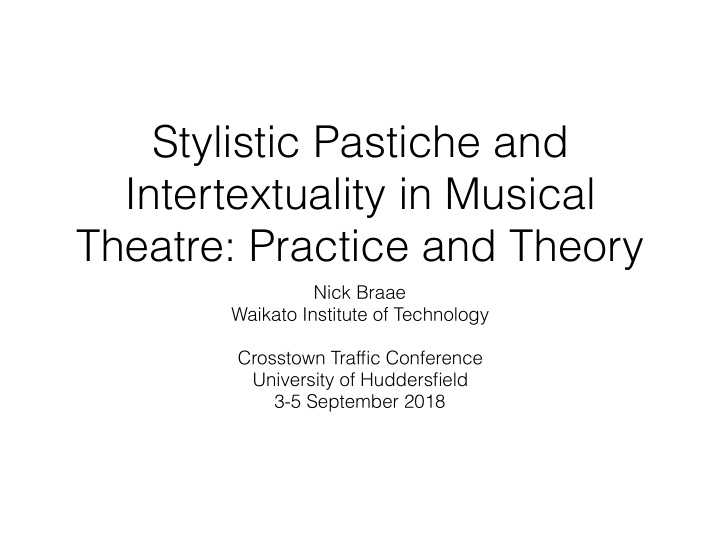



Stylistic Pastiche and Intertextuality in Musical Theatre: Practice and Theory Nick Braae Waikato Institute of Technology Crosstown Traffic Conference University of Huddersfield 3-5 September 2018
Musical Theatre Practice • The Quest (Chris Williams, 2017)—arranger • Artful Dodgers (Ross MacLeod, 2018)—co-composer (with Jeremy Mayall) and arranger • Frequent use of pastiche, drawing upon analytical work in academia (Braae 2014, 2015a, 2015b) • Imitations of Menken’s “Beauty in the Beast” (Dion/Bryson version) in “All I Want” [ The Quest : modulation by a fourth through descending harmonic pattern with 3+3+3+3+4 rhythmic grouping] • Imitation of “shout” gospel-blues in “And God Agrees” [ Artful Dodgers : general arrangement, double-time transition, vocal stylings] • Imitation of disco show-tune in “Everybody’s Got a Little Twist” [ Artful Dodgers : striding bass line, four-to-the-floor drums, horn stabs, expansive vocal arrangement] • Plus other imitations of Sherman Brothers, Queen, Bruce Springsteen, Elton John, 1980s pop, Dixieland, big band, etc.
Research Purposes • Reflect on the nature of stylistic borrowing and intertextuality as a creative and compositional device • Contribute to an analytical vocabulary of musical theatre, which is lacking in popular music studies • Understand, from a compositional perspective, how and why certain stylistic references may be appropriate and meaningful
Methodologies • Musical theatre as stylistically omnivorous (historically and contemporaneously); focus on pastiche and imitation of styles outside “current” context (of show or composition) • Style as a musical world evoked by certain characteristics (from Covach 1991, 1995; Spicer 2010, 2018; Moore, 2012) • Stylistic world constrains and establishes expectations for interpretation (Moore 2012, Coach 2003)
Pastiche, Time, and Place • Sister Act (Menken/Slater, 2005): horn/string arrangements plus rhythm section à la 1970s Philly disco • “Eddie Gets the Girl” and Hall and Oates’ “Rich Girl” (harmonic gesture and melodic fragment) • “Take Me to Heaven” and “The Sound of Philadelphia” (horn licks) • “Spread the Love Around” and The Village People (textural growth, dominant pedal point, ascending semiquaver strings) • Historical incongruities between “Take Me to Heaven” and “It’s Raining Men”
Pastiche and Emotional Tone • “Shiksa Goddess” from The Last Five Years (Jason Robert Brown, 2003) • Originally in Celtic-roots piano style (changed for legal purposes) • Played as quasi- son montuno piano style (octave patterns between LH/RH; rhythmic figuration) • Son montuno as “other” musical style (relative to Sondheim-esque tone of opening number)—mirrors the perceived exoticism of Jamie’s new girlfriend Cathy
Pastiche and Humour • Pastiche and incongruity • “Give Up Your Dreams” ( School of Rock , Lloyd Webber/Slater)—in the style of Queen • From “We are the Champions”: 6/8 groove, SRDC chorus phrasing, textural contrasts between verse and chorus, electric guitar doubling bass, triplet semiquaver fills on toms, guitar run into final chorus • From “Somebody to Love”: descending bass line in chorus • From “Barcelona”: lyrical reference to “bells ringing”; sustained vocal note over dominant pause before chorus • Pastiche as caricature • “Man Up” ( The Book of Mormon , Lopez/Stone/Parker)—in a “heroic” stadium rock style (part “Live and Let Die”, part “Eye of the Tiger”, part Meat Loaf) associated with action films; such associations fully articulated to the point of cliché and parody by lyrics; too much congruity between words and music!
Catch Me If You Can • Catch Me If You Can , Marc Shaiman; 1950s and 1960s swing (Sinatra/Martin) and lounge music • Standardised arrangements: cocktail jazz verse—crooner’s verse—stomp chorus (as per stylistic conventions) • Individual song influences: ‘Jet Set’ and ‘Come Fly With Me’ (middle-class escapism); ‘Little Boy, Be a Man’ and ‘One For My Baby’ (confessional/ personal song); ‘Stuck Together’ and ‘King of the Road’ (song about a traveller, irony of Frank being caught by Carl) • Multiple levels of the model simultaneously: the tone of ‘Little Boy’ (i.e. confessional) within the style of 1950s big band (i.e. place); or, the characters of ‘Stuck Together’ (i.e. a traveller) in an ironic context (i.e. being caught) at a historical point (i.e. 1960s) • References immediately establish interpretative tone, but have no direct influence thereafter…
Further Directions • How do songwriters in musical theatre meld pastiche with individual compositional voices? (E.g. the C-D/C chord shuttle of Menken in different stylistic guises through Sister Act, The Little Mermaid , Little Shop of Horrors ) • The compositional tropes of musical theatre itself (e.g. triplet crotchet melodies; use of iii as bridge-opening harmonic gesture; bVII-V cadences)—and thus, pastiche of musicals • The cultural implications and dynamics of style imitation (e.g. the more “pointed” references of The Book of Mormon , or the “reductive” references of Miss Saigon )
Recommend
More recommend